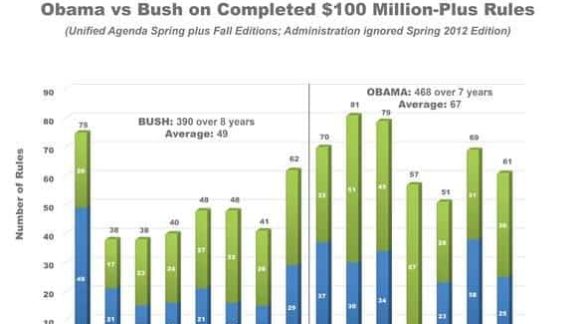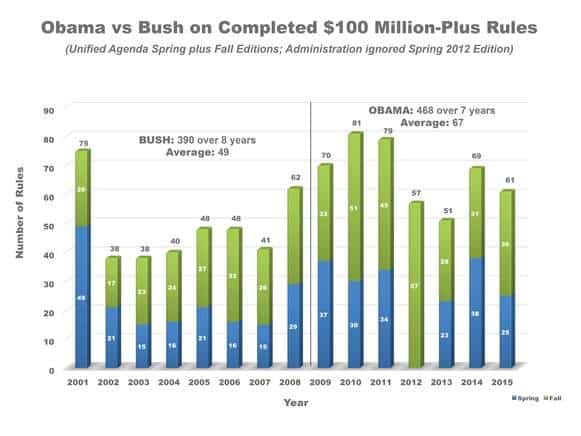The Barack Obama Regulatory State Towers over that of Bush

A glance at the overall count of rules and regulations leads one to suppose regulatory burdens are decreasing. After all, since Obama took office the total number of rules and regulations appearing annually in the Federal Register has moved from 3,830 in Bush’s last calendar year to 3,410 in 2015, as I describe in the new 2016 edition of Ten Thousand Commandments: An Annual Snapshot of the Federal Regulatory State.
There’s a deeper story though, that shows how strategic efforts to avoid traditional regulations have actually increased the burden on taxpayers. Through various tactics such as differing rule burdens, executive orders, guidance documents, and a well-documented strategic delay in unpopular rules during 2012 election cycle, President Obama’s regulatory state keeps growing.
Also, aggressive presidential executive orders and “memoranda” have changed Washington, part of what Obama meant when he said he would use the “pen and phone” to enact his agenda if Congress didn’t go along. President Bush published 129 memoranda over his entire presidency, whereas Obama issued 219 during his first seven years that were published in the Federal Register. Numerous others weren’t published in the Federal Register at all.
Also, a proliferation of agency guidance documents and other regulatory dark matter often stand in for the formal rulemaking process, and so don’t get counted as part of the regulatory burden (although I have a partial inventory here).
The Federal Register signals a more active federal government despite its rule count. At the end of 2015, the number of Federal Register pages stood at 80,260. This is President Obama’s third-highest count (he is the only president to top 80,000 pages at all, let alone three times), as well as the third-highest level in the compilation’s entire history. Of the seven all-time high Federal Register page counts, six have occurred during the Obama administration
Notably, the costliest subset of regulations, dubbed either “economically significant” or “major,” are growing in number. Let’s look at them as they appear in the Unified Agenda, which is the spot where agencies twice-annually present regulatory priorities, as well as recently completed rules.
While the overall number of rules in the Agenda has declined (as in the Federal Register), the overall number of “economically significant” rules in the pipeline during the current administration is considerably higher than earlier in the decade. President George W. Bush started an uptick; President Obama continued it. Indeed the body of “active” (pre-rule, proposed, and final) economically significant rules in the fall Agenda pipeline has topped 130 for all but the first of Obama’s seven years in office (his seven-year average is 135; the George W. Bush eight-year average was 87).
As may be seen in the nearby chart on completed economically significant rules, President Bush issued 390 over his entire eight years, an average of 49 annually. President Obama, in just seven years, has issued 468, an average of 67 annually.

The annual totals for completed economically significant rules are down from the 2010 peak of 81, standing at 61 in 2015. Yet that is still higher than any Bush year save 2001 (and also higher than the latter Clinton years, not depicted here).
The chart makes clear that the level of completed economically significant rules from 2008 forward is conspicuously higher than during the earlier part of the decade, apart from 2001. This even takes into account that only one edition of the Unified Agenda appeared in 2012. (Also, some agency “midnight regulations” may have been issued by the Bush administration in 2009 as Obama was taking office, though the Obama administration did issue a freeze to review Bush rules upon assuming office.)
Of the 3,297 regulations now in the works in the broader Unified Agenda, 674 affect small businesses. Of those, 386 required a regulatory flexibility analysis (up from 374 last year) to assess their impacts on small entities; and an additional 288 were otherwise noted by agencies to affect small businesses. The average of Obama’s first seven years was 406, greater than Bush’s eight year average of 377.
So, while we’re not letting Bush off the hook as a regulator, the numbers say the Obama administration’s output level of higher impact rules during the decade is notably greater than what was witnessed during the Bush administration.